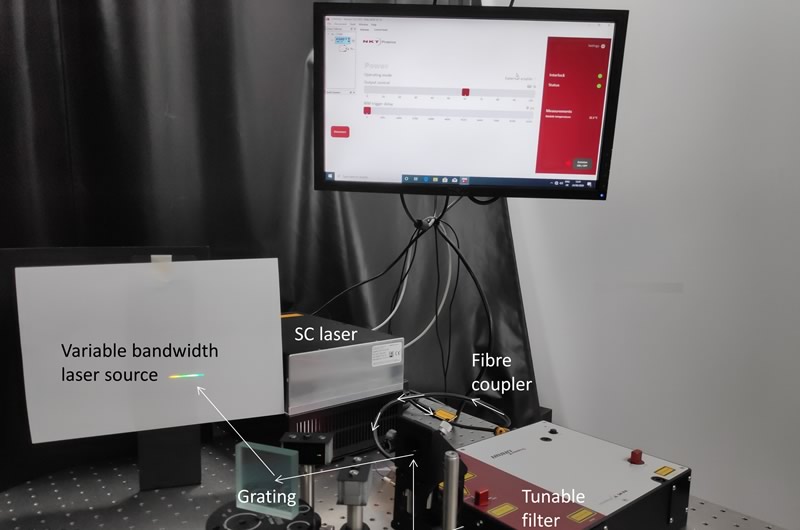CAPPA recently purchased a new optical set–up containing four components, a supercontinuum (SC) laser, a spectrometer and two scientific-grade cameras. The supercontinuum laser, SuperK Evo, is a white light laser based on extremely reliable fibre laser technology. Designed for maintenance-free operation, the laser is very stable and boasts a long lifetime. The spectrometer, Andor Shamrock 500i, is based on the Czerny-Turner optical design and pre-aligned to the camera. The scientific grade cameras, Andor iXon 855 and Andor iDus 1.7mm, cover the wavelengths from visible to near-infrared. With this new system, CAPPA will have the ability to carry out more detailed research across a variety of different sectors including pharmaceuticals, medical device, photonics, food and beverage. This equipment was funded as part of the Enterprise Ireland Capital Equipment funding call.
The SC laser source is unique as it provides a laser-quality beam, sharp and intense, over a broad spectral range, equivalent to a fluorescent bulb. As a result, the SC laser can be used for both absorption and excitation characterisation. Another significant advantage of the source is its size, smaller than a desktop computer, making it extremely portable and adaptable to a plethora of techniques. The spectrometer consists of dual detector outputs to couple both scientific-grade cameras, with a motorised triple grating turret. The three gratings are configured as follows: 1) ruled grating, 300 l/mm, 1700 nm blaze, 2) ruled grating, 600 l/mm, 500 nm blaze and 3) ruled grating, 1200 l/mm, 500 nm blaze, these enabling the generation of high- and low-resolution spectra. The first scientific grade camera contains a charge-coupled device (CCD), with a 512 x 512-pixel array, and spectrograph. The CCD provides high sensitivity, enabling detection of low light levels, along with high temporal resolution (microsecond), needed for some fluorescence applications. The second scientific-grade camera contains an InGaAs sensor optimised for near-infrared, with a 512 x 1-pixel row at a 25 mm pitch and a Peak QE of > 85%. Together, the combination allows for the construction of an abundance of microscopy and spectroscopic techniques, including VIS/NIR absorption spectroscopy, fluorescence spectroscopy and optical coherence tomography and imaging techniques via reflection, absorption or fluorescence, on a compact benchtop set-up.
The main purpose of the set – up will be as a stepping stone to providing affordable automated characterisation solutions which companies can take back on – site. Characterisation is preformed regularly on high – end expensive commercial equipment based at CAPPA. However, if the procedure is required regularly, returning to CAPPA routinely is not a realistic solution, neither is purchasing the high – end commercial equipment. Consequently, simpler specific setups are built at CAPPA to meet the needs of the routine measurements. A delay in this set comes from determining appropriate light sources and detectors remotely. The SC–CCD combination will remove this delay, allowing for the construction of benchtop VIS/NIR absorption, fluorescence, optical coherence tomography and imaging setups.
The combination will also allow an increase in sensitivity compared to commercial equipment by the construction of cavity enhanced absorption spectroscopy or intensity/frequency modulation setups. These purpose-built solutions can significantly increase sensitivity compared to other all-purpose commercial equipment. The SC–CCD can be used in applications such as fluids in the biomedical and pharmaceutical industry, in the environmental sector, particles/powders in environmental and pharmaceutical sectors, surfaces/coatings in biomedical and pharmaceutical, solids for materials characterization and light sources.
If you are interested in learning more about the facilities available at CAPPA, you can contact them here.



